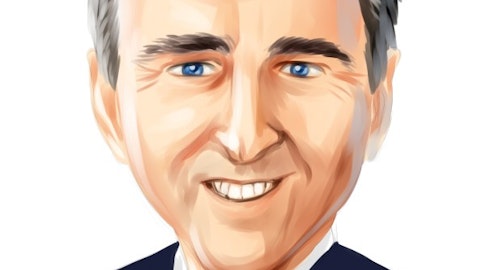Broadcom Inc. (NASDAQ:AVGO) Q4 2022 Earnings Call Transcript December 8, 2022
Broadcom Inc. beats earnings expectations. Reported EPS is $10.45, expectations were $10.28.
Operator: Welcome to Broadcom Inc. Fourth Quarter and Fiscal Year 2022 Financial Results Conference Call. At this time, for opening remarks and introductions, I would like to turn the call over to Ji Yoo, Head of Investor Relations of Broadcom Inc.
Ji Yoo: Thank you, Sherri, and good afternoon, everyone. Joining me on today’s call are Hock Tan, President and CEO; Kirsten Spears, Chief Financial Officer; and Charlie Kawwas, President, Semiconductor Solutions Group. Broadcom distributed a press release and financial tables after the market closed, describing our financial performance for the fourth quarter and fiscal year 2022. If you did not receive a copy, you may obtain the information from the Investors section of Broadcom’s website at broadcom.com. This conference call is being webcast live and an audio replay of the call can be accessed for one year through the Investors section of Broadcom’s website. During the prepared comments, Hock and Kirsten will be providing details of our fourth quarter and fiscal year 2022 results, guidance for our first quarter as well as commentary regarding the business environment.

jonas-svidras-e28-krnIVmo-unsplash
We’ll take questions after the end of our prepared comments. Please refer to our press release today and our recent filings with the SEC for information on the specific risk factors that could cause our actual results to differ materially from the forward-looking statements made on this call. In addition to U.S. GAAP reporting, Broadcom reports certain financial measures on a non-GAAP basis. A reconciliation between GAAP and non-GAAP measures is included in the tables attached to today’s press release. Comments made during today’s call will primarily refer to our non-GAAP results. I’ll now turn the call over to Hock.
See also 10 Best Performing Energy ETFs in 2022 and 15 Richest Hedge Fund Managers in the World
Hock Tan: Well, thank you, Ji. And thanks, everyone, for joining us today. Before I provide color on our Q4 results, let me put in perspective what we achieved in fiscal year €˜22. For the year, I’m pleased to report that consolidated revenue hit a record of $33.2 billion, growing 21% year-on-year, yet another year of double-digit organic growth. This growth was driven by our strong partnerships with customers and increased R&D investments, which enable accelerated adoption of our next-generation technologies. With our robust business model, we grew our fiscal 2022 operating profit by 28% year-on-year and our free cash flow per share by 25% year-upon-year. Now to discuss details of our fiscal Q4. In our fiscal Q4 €˜22, consolidated net revenue was a record $8.9 billion, up 21% year-on-year.
Semiconductor solutions revenue increased 26% year-on-year to $7.1 billion, and infrastructure software revenue grew 4% year-on-year to $1.8 billion. In Q4, our semiconductor business continued to perform well across hyperscale, service providers and enterprise. On top of this, wireless grew sequentially as we ramp up the new platform and our North American customer. In reporting these results, I’d like to emphasize, we demonstrate our continued discipline in shipping our strong backlog only as and when needed by our end customers. So, in contrast to weak consumer electronics spending today and despite concerns of a global recession, we believe overall infrastructure spending remains strong, and we continue to experience sustained demand in most of our end markets, and this is what we continue to see in Q1.
So, let me expand on this. Starting with networking. Networking revenue was a record $2.5 billion and was up 30% year-on-year, representing 35% of our semiconductor revenue. We see strong growth from deployment of Tomahawk 4 for data center switching at hyperscale customers. And we see upgrades of edge and core routing networks with our next-generation Jericho portfolio at cloud and service providers. And at multiple cloud customers, we continue to lead in delivering custom solutions for compute offload accelerators and actually surpassed the $2 billion amount in revenues in fiscal €˜22. Looking into Q1, we do expect networking revenue to be strong and grow about 20% year-over-year. Next, our storage connectivity revenue was a record $1.2 billion or 17% of semiconductor revenue and up 50% year-on-year.
As we have mentioned in previous earnings call, we are benefiting here from substantial content increases as both, cloud and enterprise customers adopt our next-generation MegaRAID and storage adapters. This trend will continue in Q1, and we expect server storage connectivity revenue to grow above 50% year-on-year. Moving on to broadband. Revenue of $1 billion grew 20% year-on-year and represented 15% of semiconductor revenue. Our broadband business is benefiting from ongoing multiyear deployments by North American and European service providers of 10-gigabit PON and DOCSIS 3.1 with embedded Wi-Fi 6 and 6E. In Q1, we expect the secular drivers behind broadband to continue and our business to be strong at about 30% year-on-year growth. Moving on to wireless.
Q4 revenue of $2.1 billion represented 29% of semiconductor revenue with the 13% year-on-year increase coming largely from higher content. And in Q1, we expect wireless revenue to be sequentially flat and up low single digits year-on-year. Finally, Q4 industrial resale of $234 million grew 1% year-over-year as softness in China mostly offset the strength in North American and European automotive. In Q1, we forecast industrial resales to continue the trend of low single-digit percent growth year-on-year. And so in summary, Q4 semiconductor solutions revenue was up 26% year-on-year. And in Q1, we expect semiconductor revenue growth to sustain at approximately 20% year-on-year. Moving on to software. In Q4, infrastructure software revenue of $1.8 billion grew 4% year-on-year and represented 21% of total revenue.
Core software revenue grew 5% year-on-year. In spite of adverse ForEx impact in dollar terms, consolidated renewal rates averaged 117% of expiring contracts. And in our strategic accounts, we averaged 128%. Within our strategic accounts, annualized bookings of $357 million included $101 million of cross-selling of our portfolio of products to these customers. Over 90% of the renewal value represented recurring subscriptions and maintenance. Over the last 12 months, consolidated renewal rates averaged 120% over expiring contracts. And in our strategic accounts, we averaged 135%. Because of this, our ARR, which is annual recurring revenue, the indicator of forward revenue, at the end of Q4 was $5.4 billion, which was up 4% from a year ago. And in Q1, we expect our infrastructure software segment revenue to be flat year-on-year, reflecting core software revenue growth of mid-single-digit percent year-over-year, offset by a year-on-year decline in the Brocade enterprise and business.
In summary, we’re guiding consolidated Q1 revenue of $8.9 billion, up 16% year-on-year. While we are fully booked for fiscal 2023, in this environment, we are not providing you guidance for the year. Before Kirsten tells you more about our financial performance for the quarter, let me provide a brief update on our pending acquisition of VMware. We are making progress with our various regulatory filings around the world, as we very much expect having received merger clearance in Brazil, Canada and South Africa. We anticipate that time line for the review process would be more extended in other key regions, especially given the size of this transaction. Having said that, we’re still confident that this transaction will close and be completed in our fiscal 2023.
The combination of Broadcom and VMware is about enabling enterprises to accelerate innovation and expand choice by addressing their most complex technology challenges in this multi-cloud era. And we are confident that regulators will see this when they conclude their review. With that, let me turn the call over to Kirsten.
Kirsten Spears: Thank you, Hock. Let me now provide additional detail on our financial performance. Revenue was $8.9 billion for the quarter, up 21% from a year ago. Gross margins were 75% of revenue in the quarter and up 10 basis points year-on-year. Operating expenses were $1.2 billion, up 3% year-on-year, driven by investment in R&D. Operating income for the quarter was $5.5 billion and was up 25% from a year ago. Operating margin was 62% of revenue, up approximately 240 basis points year-on-year. Adjusted EBITDA was $5.7 billion or 64% of revenue. This figure excludes $129 million of depreciation. Now, a review of the P&L for our two reportable segments. Revenue for our semiconductor solutions segment was $7.1 billion and represented 79% of total revenue in the quarter.
This was up 26% year-on-year. Gross margins for our semiconductor solutions segment were approximately 71%, up 70 basis points year-on-year driven by product mix and adoption of next-generation products across our extensive product portfolio. Operating expenses were $825 million in Q4, up 4% year-on-year. R&D was $731 million in the quarter, up 4% year-on-year. Q4 semiconductor operating margins were 59%. So, while semiconductor revenue was up 26%, operating profit grew 33% year-on-year. Moving to the P&L for infrastructure software segment. Revenue for infrastructure software was $1.8 billion, up 4% year-on-year and represented 21% of revenue. Gross margins for infrastructure software were 91% in the quarter and operating expenses were $348 million in the quarter, down 1% year-over-year.
Infrastructure software operating margin was 72% in Q4, and operating profit grew 6%. Moving to cash flow. Free cash flow in the quarter was $4.5 billion, representing 50% of revenue. We spent $122 million on capital expenditures. Days sales outstanding were 30 days in the fourth quarter compared to 29 days in the third quarter. We ended the fourth quarter with inventory of $1.9 billion, up 5% from the end of the prior quarter because we expect the mix of revenue in Q1 to have a higher cost of materials. We ended the fourth quarter with $12.4 billion of cash and $39.5 billion of gross debt, of which $440 million is short term. Based on current business trends and conditions, our guidance for the first quarter of fiscal 2023 is for consolidated revenues of $8.9 billion and adjusted EBITDA of approximately 63% of projected revenue.
In forecasting such operating profitability, we would like to point out that because of product mix changes, our non-GAAP gross margin could be down roughly 100 basis points from Q4 and R&D spending could be up sequentially as we step up hiring of engineers for multiple critical projects. Let me recap our financial performance for fiscal year 2022. Our revenue hit a record $33.2 billion, growing 21% year-on-year. Semiconductor solutions revenue was $25.8 billion, up 27% year-over-year. Infrastructure software revenue was $7.4 billion, up 4% year-on-year. Gross margin for the year was 76%, up 110 basis points from a year ago. Our operating expenses were $4.8 billion, up 6% year-on-year. Fiscal €˜22 operating income was $20.3 billion, up 28% year-over-year and represented 61% of net revenue.
Adjusted EBITDA was $21 billion, up 27% year-over-year and represented 63% of net revenue. This figure excludes $529 million of depreciation. We spent $424 million on capital expenditures. And free cash flow grew 22% year-on-year to $16.3 billion or 49% of fiscal €˜22 revenue. Turning to capital allocation. For fiscal €˜22, we spent $15.5 billion, consisting of $7 billion in the form of cash dividends and $8.5 billion in repurchases and eliminations. We ended the year with $13 billion of authorized share repurchase programs remaining and expect to resume our repurchase of common stock as soon as we can under SEC rules. Excluding the potential impact of any share repurchases, in Q1, we expect the non-GAAP diluted share count to be $435 million.
Aligned with our ability to generate increased cash flows in the preceding year, we are announcing an increase in our quarterly common stock cash dividend in Q1 fiscal 2023 to $4.60 per share, an increase of 12% from the prior quarter. We intend to maintain this target quarterly dividend throughout fiscal €˜23, subject to quarterly Board approval. This implies our fiscal 2023 annual common stock dividend to be a record $18.40 per share. I would like to highlight that this represents the 12th consecutive increase in annual dividends since we initiated dividends in fiscal 2011. That concludes my prepared remarks. Operator, please open up the call for questions.
Q&A Session
Follow Avago Technologies Ltd (NASDAQ:AVGO)
Follow Avago Technologies Ltd (NASDAQ:AVGO)
Receive real-time insider trading and news alerts
Operator: Thank you. And today’s first question will come from C.J. Muse with Evercore ISI. Please go ahead.
C.J. Muse: You talked about infrastructure holding up well across most segments. I guess, I was hoping you could speak more to why infrastructure to date has been so immune from the weakness we’ve seen elsewhere in semis. Specifically, can you speak to trends you’re seeing perhaps in hyperscale versus enterprise? Any differences there? And also, can you speak to how you see these trends throughout all of fiscal €˜23? Thanks so much.
Hock Tan: All right. Great question. What we see now, last quarter and this current quarter as we progress is hyperscale spending continues strong; enterprise consumption continues strong; and broadband deployment across North America, Europe and even parts of Asia continues their multiyear trend of growth simply because out of COVID-19, there was a lot of invest — there was a lot of plans to invest, and these are multiyear. So, exactly as I said, all these areas currently continue to be very much on track as we’ve seen it. Now, keep in mind, as I said in previous earnings call and I’d just reemphasize here today, again, it’s — I just want to assure you, we don’t believe we are shipping beyond true demand. We continue to scrub — to basically judge orders, the backlog we have, and we also take pains to only ship to customers who can consume it pretty much within the same quarter before we do it.
And so, as far as we can tell, based on what we see as a willingness of our customers to accept and consume the products we ship, that’s what we see right now. Asking me for the rest of €˜23, no, I tend to be more careful in being able to answer that. I don’t know the answer to that is my opinion. I do not know whether the strength in acquisition and consumption of our products will continue to sustain for the rest of €˜23. What we do see is over the next several months, we see those orders still in place. We see customers willing to take the products. We have — talking to multiple, multiple CIOs among largest enterprise customers we have out there. We have not seen them talk about a reduction in their IT spending. We’ve seen many said it will grow and others saying it will at least remain flat.
So, I guess, I’m cautiously positive about trends looking forward.
Operator: Thank you. One moment for our next question. That will come from the line of Ross Seymore with Deutsche Bank. Please go ahead.
Ross Seymore: Hock, I want to follow on C.J.’s and maybe ask similar question but in a slightly different way. Last quarter, you talked about actively scrubbing your backlog. And clearly, that’s helped to avoid some of the inventory pitfalls that some of your peers have seen. But have you noticed since last quarter’s call a change in either the rate of your backlog growth? I think it was up about 7% sequentially last quarter, the composition of your backlog or how actively and aggressively you need to scrub it? Any sort of changes in those forward-looking metrics that would alter your view on kind of the sustainability of demand, the duration of it, et cetera?
Hock Tan: It comes down very simply to we continue to scrub our backlog in a manner this quarter, last quarter, no differently than we did it six months or a year ago. We haven’t changed our focus on ensuring that we do not ship products to the wrong people who just put it on the shelves. That is still very much, very, very intact in our view. Our backlog continues to be way up there, and you’re right, makes us change. As you can see, one quarter, it would be broadband growing 20% year-on-year and networking growing 30% year-on-year, and the following quarter is broadband growing 30% year-on-year and networking growing 20%. And it impacts not just from hyperscale bearing their purchases in — for one of a better word, seasonal manner; it’s also the particular end markets it goes to.





